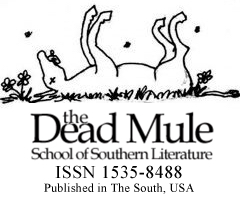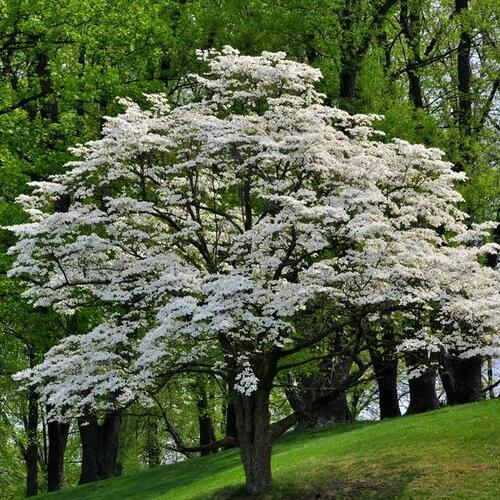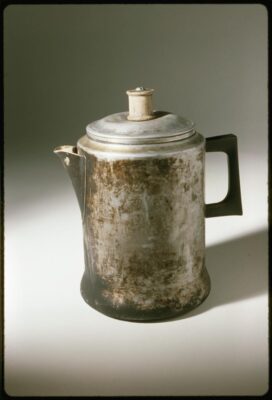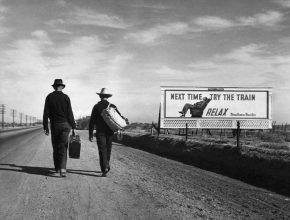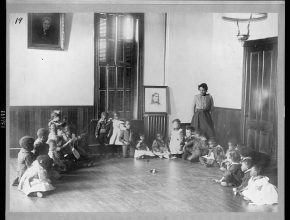Southern Legitimacy Statement: After growing up in the Old Dominion, a creeping dissonance and yearning for a different world led me to leave. Though I’ve happily rebadged myself from Virginian to Pacific Northwesterner, I still have a hankering for warm ocean waves, fireflies, and decent hushpuppies. Virginia with all its complexity still has a hold on me.
Dogwood, an uncertain truth
Cornus Florida, the flowering dogwood native to the eastern United States, is the Virginia state tree. It is as ubiquitous and iconic as the state bird, the vibrant red cardinal that poses on a dogwood’s thin twisted branches as if sitting for the ultimate portrait of the Commonwealth. Of the four species of dogwood found in North America, Cornus Florida is said to have the most stories to its name.
The dogwoods I love most grow wild. Branches of delicate blossoms float in the understory of the Virginia hardwood forest and even in the verdant evergreen timberland of the Pacific Northwest. When I happen upon a dogwood in the wild, my mind flashes to another time in a different woods. I think of walking with my mother near my Virginia childhood home. A talkative woman often accused of seeing the world through rose-colored glasses, my mother became calmer in nature. She would pause to peer in the open end of a downed tree or look up to marvel at whatever bird was twittering at our presence. One day when we happened upon a dogwood she stopped to bend a branch toward us.
“Did you know there’s a story about Jesus and the dogwood?” she asked as she fingered the delicate white blossom in her palm. I traced the scalloped edges of the four petals clustered around a thistle-like core at the center of the flower. The blossom felt creamy, a contrast to the scratchy pine needles under our feet. I listened as she explained the four petal-like bracts were arranged in memory of Jesus.
My mother shared a story that has its origins in a Christian legend from the early 20th century. The story claims the dogwood tree once grew straight, strong, and tall, and thus, it was the tree chosen to construct the cross for Jesus’ crucifixion. To punish the tree for its sordid role, God cursed the dogwood to be small with a gnarled trunk and sprawling tiers of branches so that it could never again be used for building a cross. God then blessed the tree with beautiful flowers to bloom each spring just in time for Easter – each flower with four bracts, two long, two short, to form a cross. The small spiky center represents a crown of thorns, the story says, and the indented tips of each bract are tinged red as reminders of how Jesus bled at the crucifixion.
I didn’t know how to reconcile the damnation of God with the song ringing in my head. Jesus loves me, this I know. I didn’t know ifDogwood trees grew in the Middle East in Jesus’ lifetime, or ever. It was hard to conjure an image of Jesus bleeding on the cross on this early spring day with new life budding all around us in the woods we both loved. I wondered who told my mother the story and if she believed it. It sounded like a fairy tale to me.
In the Pacific Northwest, dogwood flowers are usually pink or yellow; in Virginia, the blossoms are a creamy white, sometimes with a greenish hue. All the species belong to the genus known in botanical Latin as Cornus for “hard.” Historians theorize early Europeans prized thin stems from the dogwood to make daggers, thus calling the tree “dagwood.” Thomas Jefferson is credited with introducing the use of the flowering dogwood as an ornamental in landscaping in the late 1770s. He planted dogwoods at his home at Monticello and in the gardens of the nearby University of Virginia, the “academical village” Jefferson designed in 1822.
On a family trip to Virginia, I shared what I loved most in my home state with my husband and sons. We stayed in a rustic cabin in the Shenandoah Valley, lolled by the Shenandoah River, and hiked in Shenandoah National Park. We booked a quaint restored cottage on a sheep farm and hiked my favorite waterfall. We continued to Monticello where, standing amidst the dogwoods, the tour guide detailed facts missing from my childhood visits: That Jefferson split up slave families based on their projected labor output. That he fathered five children with one of his slaves. I noticed my son’s face cloud over. “It’s just not right,” he said. Only a few hours later we walked the lawn at the University to admire more of Jefferson’s work. One month later to the day white nationalists marched along the same stone path shouting “Unite the Right!” as they held blazing torches high.
My understanding of my provenance is as twisted as the limbs of the dogwood tree. Angst and beauty are entwined in stories nestled deep in my memory, stories that resurface when I happen upon a dogwood in the wild. What I cherish are memories of my mother’s joy in sharing her rose-colored world with me. What rattles me are the images I didn’t question at the time. Standing with my son at Monticello I felt the tension of holding the brilliance of Jefferson while acknowledging his legacy as a slave owner. To continue to ignore this, one of many obvious contradictions from my heritage, is to dismiss an indelible part of my ancestry.
—-
When I was little we had a lady come to the house once a week to help with the ironing and some other household chores. Her name was Louise but I called her Miss Easy. It always made her smile. My grandmother had an ironing lady but I don’t remember her name. She smiled too but not as much. Both of the ladies were Black. Neither my mother nor my grandmother worked outside the home. All the white ladies had help and I wondered why help was needed. I wondered if the Black ladies liked their jobs helping my mother and grandmother. Did they smile the same at night, going home to take care of their own families? Warm inviting eyes, easy smiles. Did they ever tire of smiling? Aunt Jemima smiled from the maple syrup bottle. Uncle Ben smiled from the box of rice. The lawn jockey with the lantern posed stoically at the end of driveways in the neighborhood. Smiles fixed in perpetuity.
When I was six I thought my father’s mother had the best snacks. Pepperidge Farm cookies and Planters mixed nuts. I would fish around in her cut glass candy dish for the cashews and pecans, avoiding the peanuts (so many peanuts in Virginia), and pause at the large off-white nuts shrouded in a dark peel.
“What are those?” I asked. “We call those nigra toes,” she said.
I didn’t know this word but it sounded like another word I’d heard. The bad word. Her word sounded different but still, my skin crawled. An image of amputated toes crossed my mind. I was confused someone’s skin would be associated with a nut. I had heard the grown-ups call foolish people “goobers,” slang for peanuts. Was this the same thing? The word stuck deep in the crannies of my young brain. Decades later I would see my grandmother’s word listed in an online dictionary as a synonym for the n-word. All these years I thought my grandmother was trying to avoid saying a word she didn’t want me to hear. I cannot see a Brazil nut to this day without hearing her voice.
Back-to-school shopping was a favorite outing in the dog days of August. My mother and I would travel from our home in the suburbs to the Miller & Rhoads department store that commanded a whole city block in downtown Richmond. With my pale blue cat-eye glasses, blotchy freckles, humidity-frizzed blond locks, I stood out in noticeable contrast to my mother. She glowed in the summer with her deeply tanned olive complexion, brown eyes, brunette bob. She liked to say she was Cherokee and I never was sure if she was joking. In the shoe department the sales lady laced up the saddle shoes on my feet which seemed to be growing faster than the rest of my body.
“There, how does that feel?” the sales lady said. She turned to my mother and asked, “Is she adopted?”
My mother’s mother was married three times. She was called “mama” by her last husband in his syrupy sweet nasally voice. I remember thinking he was awkward with his sappy affection, yet what I remember most is how he used the n-word in nearly every conversation.
I went to a private school in ninth grade, the year we moved from the suburbs to an apartment complex in the city. It also was the year of court-ordered busing, or what everyone called “forced busing,” in Richmond. At James River Academy I attended classes with a bunch of white kids like me from neighborhoods all over the city. Now I know it was a segregation academy.
When I think of history in my place of birth I think of the Confederate statues on Monument Avenue, which was promoted in tourism brochures as “America’s most beautiful boulevard.” Giant bronze men, most mounted on horses, were memorialized for more than a century for leading a war they lost. We drove often along the cobblestone blocks of that leafy boulevard, veering around broad traffic circles and through wide intersections all designed to steer our attention to Confederate military heroes Robert E. Lee, Jefferson Davis, Jeb Stuart, Stonewall Jackson, and to Matthew Fontaine Maury, the naval oceanographer who advocated international expansion of slavery.
When I think of progress in my place of birth I think of the Confederate pedestals splashed with graffiti. I think of Kehinde Wiley’s sculpture Rumors of War, placed strategically in front of the state history museum. The last time I was there an elderly white man sat a few feet away, flying the Confederate flag with his sign, “Save Our Monuments!” Now, nearly all the Confederate monuments are gone in the aftermath of the 2020 protests. Homeowners are suing to block the removal of the Robert E. Lee monument, six stories tall and the only Confederate icon still standing. They say their property values will fall if the neighborhood’s designated status as a historic landmark district is threatened.
Richmond is known for its architecture. One of the most stunning examples is the Commonwealth Club, a red brick Italian Renaissance Revival mansion built in 1891. I once worked at an advertising agency a few blocks away and as I walked by I wondered about the interior, imagining the elegance of the parlors. My fascination faded when I learned that for decades no Black, not even Richmond’s first Black mayor in 1977, was invited to membership. “A racist club, a retreat from the world where social gains are being made,” our Black Congressman once declared.
One humid August afternoon when I was 19 a middle-aged woman walked up to me on a sidewalk in downtown Richmond, stared into my eyes, and declared:
“One of my granddaddies was white and one of my granddaddies was Black, now what are you going to do about it?”
The woman’s brown eyes bore into my stunned face, her manic expression signaling this was an issue that had jangled her thoughts all her life. My heart jumped. I had no words to answer, then I realized she wasn’t expecting a response. She muttered and passed me by. Why me? I wondered. How many other people has she asked? I was dazed, not from the heat. Now I know only 10 years had passed since the Supreme Court’s unanimous Loving v. Virginia ruling declared anti-miscegenation laws unconstitutional. For decades Virginia’s Racial Integrity Act had prohibited interracial marriage to reinforce racial segregation. Years of public shame were a part of the woman’s history. Her story could not be changed.
The hospital where I was born is located a block from the gray stucco mansion where Jefferson Davis lived and orchestrated the Civil War. It is a v-shaped grubby red brick tower with stacks of small black-rimmed windows. I have a dim memory of waking up in the same hospital when I was about six years old. I peered through the rails of a crib that had been parked in a corridor not far from nurses milling about their station. My throat hurt from the surgery to remove my tonsils.
“Would you like some ice cream?” said a voice in a white uniform. Now I know my stay happened around the time the hospital officially ended its practice of segregated floors.
I grew up in the Capital of the Confederacy in a black and white world.
I’m still wrestling with an answer for that troubled woman on the street corner.
